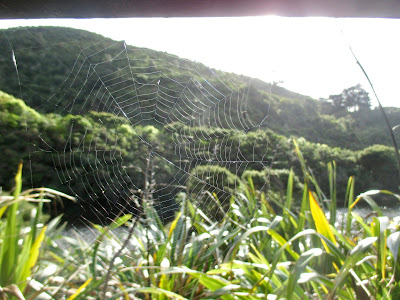I have posted about Zealandia before, so you can click here if you'd like to see my post from May 2017, and click here to see the one from back in July 2016. I am thinking that this one will not overlap much with either of those, as I've included mainly new things, but hopefully it will be interesting even if I end up with some repetition.
This time, I went with my friend Belinda, who had come to visit from Whanganui and had never been to Zealandia. We had a lovely walk when she was here, and then I used my ticket, which is good for two days, to have a solitary stroll the next day after she'd gone home. Both were wonderful.
This, apparently, is what happens when a frond gets broken off of a mamaku (black tree fern) right where it joins to the trunk. It looked like sap, and so I was expecting a hard, sticky, somewhat crystalline substance, but I was wrong. It was like jelly, and was amazing to touch, because my finger glided around the globules and came away slightly wet, but not sticky. J informs me that this is because it's made of cellulose, and I'll believe him. It is still sap, just a very different kind than other trees have.
Just to give you some context, this is what mamaku (black tree ferns) look like.
I also learned about this plant, called Tutu (Coriaria arborea). The sign at Zealandia, which I uncharacteristically took the time to read in its entirety, read as follows:
"Surely one of the more infamous plants in NZ, tutu is a native shrub that can grow to 8m. Every part of this tree, except for the juice of the swollen purple petals, contains the poison tutin. Many cases of stock death were recorded by early farmers - even circus elephants have fallen victim to this fatal poison. Honey derived from bees gathering honeydew produced by sap sucking insects feeding on tutu has accounted for many cases of poisoning amongst humans.
Despite its fearsome reputation tutu does have beneficial uses. Māori mashed the tender shoots into poultices for bruises, cuts and boils. They even made a refreshing drink from the juice of the petals. The fruits and seeds are favourites of birds and insects and unfortunately possums."
Interesting, right?
I'm including this and the following picture to demonstrate how incredibly up close and personal the birds got while I was walking quietly by myself. You can see a Tīeke (Saddleback) in the shadows of this picture, and it was just a couple feet away from me. (There are better internet pictures in my other post, but I'm proud to have gotten one myself.)
This Toutouwai (North Island Robin), which looks depressingly far away in this picture, was really very close to me, along with several of her buddies. (Again, better internet pictures in other posts.)
I may have raved about this before, but seriously, can you see how many pinecones are on this tree? So many! Sometimes you can barely see the branches themselves because they are so covered!
Lovely view out over the sanctuary. Have I mentioned that it is 225 hectares? That is almost a square mile, which didn't sound as impressive as I'd thought, but he assured me that it is massive. Anyway, it seems like its own world when you're in it, despite being just a few minutes from the city.
I love little bush tracks. I love chatting with friends as I enjoy being out in nature, and I love walking by myself and really taking in everything around me. I'm working on slowing down and being present in my life, and this is a great way for me to do this.
I don't know if I've shared this before, but I love spiderwebs. I find them strikingly beautiful and endlessly fascinating. My camera didn't feel the same way, and had to be wheedled into focusing on it instead of the background, but it was totally worth it.
Well, that's all for this visit, but I'm sure I'll make some more wonderful discoveries next time I go.









No comments:
Post a Comment